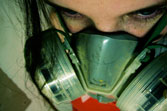Airborne/Foodborne Illness
 The mode of being healthy includes, as defined by the World Health Organization, " [...] a state of complete physical, mental and social well-being and not merely the absence of disease or infirmity".
The mode of being healthy includes, as defined by the World Health Organization, " [...] a state of complete physical, mental and social well-being and not merely the absence of disease or infirmity".
Airborne transmission of an illness occurs when bacteria or viruses travel on dust particles or on small respiratory droplets that may become aerosolized when people sneeze, cough, laugh, or exhale. They can travel on are currents over considerable distances and are loaded with infectious particles.
Foodborne illnesses are caused by a variety of foodborne pathogenic bacteria, viruses, prions or parasites that contaminate food. Commonly referred to as food poisoning, foodborne illness is any illness resulting from the consumption of food.
If there is a concern toward the possibility of a possible airborne or foodborne illness, notify your building proctor, dean or director of the affected facility. They in turn will notify Texas A&M Environmental Health and Safety.
The campus will begin immediate investigation to determine nature of illness and simultaneously contact appropriate medical personnel for assistance. TAMUG will notify Student Health Services medical personnel and will coordinate actions and activities as necessary.
Medical staff will authorize treatment on-site or transport of affected personnel to available medical facilities for treatment.
In the event of a suspected airborne or foodborne illness, Student Health Services personnel will immediately contact EHSD and will coordinate activities as necessary.
Pandemic Threats
In the case of a pandemic threat, such as pandemic influenza, actions will be taken based on the location and level of transmission of a virus. Faculty, students and staff of Texas A&M will be directed to follow actions given by the university based on the level of outbreak.
Support Links